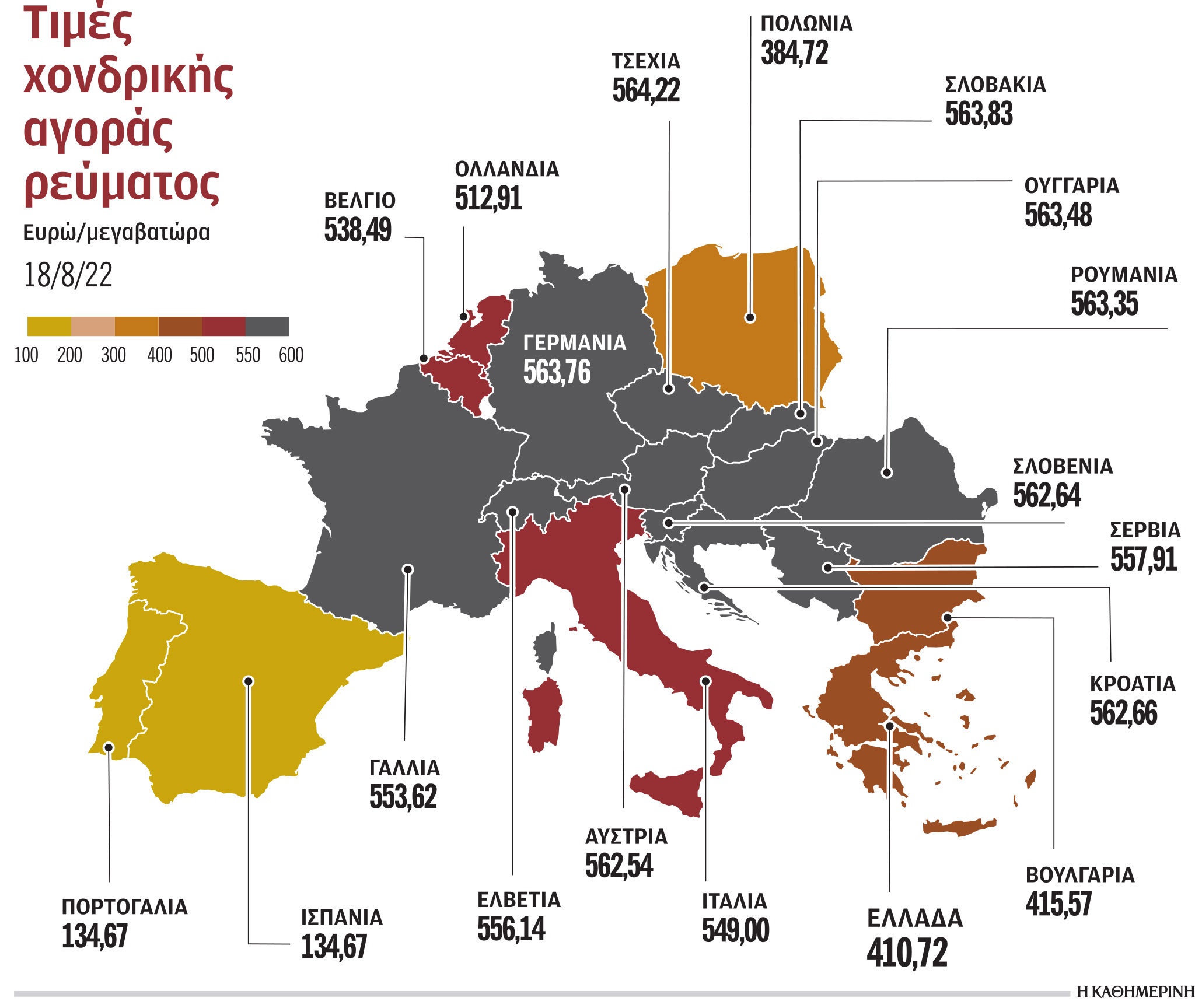
Record electricity prices in September do not take into account the big picture emerging in Europe energy market based on your price natural gas, which now steadily exceeds 200 euros per megawatt-hour. Her predictions are scary Russia for the average price of exported natural gas more than doubling this year, to $730 per thousand cubic meters, from $304 last year, while cuts in nuclear generation in France and hydroelectric power plants in Western Europe further pressure on electricity prices, as a result of lowering the level of rivers due to drought.
Ominous Predictions
Supply companies’ forecasts for electricity prices in September are disappointing, but the government’s concern is also obvious financial staff about the ultimate cost of the subsidies, as rising prices turned his calculations upside down. The cost of government measures to eliminate it energy crisis from 800 million euros in the second half of 2022, it reached 1.35 billion euros in August and, as the Minister of Finance estimated yesterday Christos Staikouras, if the price of natural gas remains at 230 euros, the cost will reach 2 billion euros, raising the total cost for 2022 to 6 billion euros. The evolution of natural gas and electricity prices is the biggest source of concern for financial staff, both Mr. Staikouras and the Deputy Finance Minister acknowledged in yesterday’s interviews. Theodor Skylakakis. And it could not be otherwise, not only because energy prices are the main source of fuel for inflation, but also because of the threat of a fiscal collapse caused by the ever-increasing costs of social support measures. For example, based on the forecasts of the supply companies for electricity prices in September, the subsidy, in order to keep tariffs at the level of 15-17 cents per kilowatt-hour, as committed by the government, should rise above 400 euros or megawatt-hours. from 337 euros in August.

Retailers on Saturday, August 20, will have to announce tariffs for September consumption, which consumers will see on their accounts for October and according to the estimate. switch to “K” we won’t see a price below 60 cents per kilowatt-hour, when in August the lowest tariff was 48.6 cents and only two companies charged above 60 cents. The price lists of the companies will be finalized in point five to minimize the risk of the forecast amid growing market uncertainty, while not expecting any pleasant surprise that would lead to a de-escalation. On the contrary, according to their estimates, there will be a significant increase in prices in the wholesale market in the coming days for two reasons that will disappear and that held back prices in the first two weeks of August.
In the coming days, megawatt-hours are expected to rise above 450 euros, possibly even 500 euros.
One of them is the resumption of the submarine electrical connection with Italy, which was delayed for technical reasons. Exports to the neighboring very expensive Italian market (549 euros per megawatt-hour yesterday) will pull up prices on the domestic market as well. The second reason is the reduction in the production of RES due to heat.
Sales executives estimate that in the coming days, prices will exceed 450 euros per megawatt-hour and possibly exceed 500 euros. To date, the price on the wholesale market has shown a slight decrease compared to yesterday (by 1.4%) and has been set at 410 euros per MWh, with a maximum price of 656 euros. Prices in Europe today continue to move at a high level: MWh reaches 563 euros in Germany, 553 euros in France, 549 euros in Italy and more than 500 euros in all other European markets, with the exception of the “exception” countries, that is, Poland. (which supports the right to free use of CO2) and the price is set at 384.72 euros, and in the Iberian countries (in exceptional cases a price ceiling is set for natural gas), where the price is set at 134 .67 euros.
Debt explosion
High prices create extreme market conditions, draining supplier companies’ liquidity and making it difficult to pay bills even after subsidies. This is indicative of the concern that the RAE expressed to the competent Minister Kostas Skrekas in a letter regarding debts to suppliers exceeding 1 billion euros, as well as an increase in the number of consumers who … are switching to a catholic service, as providers complain about more and more contracts due to for unpaid debts. The said service, which mainly hosts Batakhtsi, added 35,500 meters in the second quarter of the year, increasing the number of consumers under its auspices by 24%, to about 182,000. It is even surprising that the RAE decided to make a Catholic service more attractive to consumers by choosing the second most expensive kilowatt-hour on the market, and not the first, as it was before. 70% of consumers in the Catholic service, according to the market, do not pay and will bequeath to companies damages.
Source: Kathimerini
Lori Barajas is an accomplished journalist, known for her insightful and thought-provoking writing on economy. She currently works as a writer at 247 news reel. With a passion for understanding the economy, Lori’s writing delves deep into the financial issues that matter most, providing readers with a unique perspective on current events.